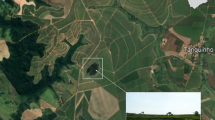Abstract
Water table fluctuation (δh) can be used to rapidly assess changes in groundwater storage. But δh gives acceptable results only if the point of observation is ideally located in the catchment of interest and gives average δh of the area, a condition which is rarely met. However, if large numbers of observation wells are located within a basin (a catchment) the average δh can be computed and used. But, a better way is to use points obtained by shallowest water level and deepest water levels to construct a wedge of water table fluctuation across the area of interest; the mean height of this wedge can be assumed to be the mean δh in the area. And when there is only one observation well, the fact that water table is a subdued replica of the topography, is made use to construct the wedge of water table fluctuation. The results from some randomly selected observations in typical semi-arid, hard rock environment in Andhra Pradesh show that through this approach mean δh can be effectively used to get change in groundwater storage in area. The mean recharge obtained in this study is in the order of 75 and mean draft is 58 mm/a, while mean recharge and draft obtained by conventional technique are 66 and 54 mm/a, respectively. The most likely specific yield around the middle reaches of a catchment ranges between 0.012 and 0.041 which is within the range given by Groundwater Estimation Committee of India for hard rocks.
Similar content being viewed by others
References
Apsgwd (2002). Groundwater Resource of Andhra Pradesh, Andhra Pradesh State Ground Water Department, Government of AP, Hyderabad-63.
Apsgwd (2005). Groundwater Resource of Andhra Pradesh, Andhra Pradesh State Ground Water Department, Government of AP, Hyderabad-63.
Apsgwd (2007). Groundwater Resource of Andhra Pradesh, Andhra Pradesh State Ground Water Department, Government of AP, Hyderabad-63.
Athavale, R. N. (1985). Nuclear tracer techniques for measurement of natural recharge in hard rock terrain. In: Proceedings of international workshop on rural hydrology in Fissured Basement Zone. Dept. of Earth Sciences, University of Roorkee (pp. 71–80).
GEC (1997). Report of Ground Water Estimation Committee, Central Ground Water Board, Ministry of Water Resources, Government of India.
GEC (2004). Report of Ground Water Estimation Committee, Central Ground Water Board, Ministry of Water Resources, Government of India.
Gupta, C. P., Thangarajan, M., & Rao, G. V. V. S. (1985). Evolution of regional hydrologic set-up of a hard rock aquifer through R-C analog modal. Groundwater, 23, 331–335.
Healy, R. W., & Cook, P. G. (2002). Using groundwater levels to estimate recharge. Hydrogeology Hydrogeology Journal, 10, 91–109.
Karanth, K. R. (1987). Ground water assessment, development and management. New Delhi: Tata Mcgraw Hills.
Raj, P. (2001). Trend analysis of groundwater fluctuations in a typical groundwater year in weathered and fractured rock aquifers in parts of Andhra Pradesh. Journal of the Geological Society of India, 58, 5–13.
Raj, P. (2004). Classification and interpretation of piezometer well hydrographs in parts of southeastern peninsular India. Environmental Geology, 46, 808–819.
Reddy, N. T., Prakasam, P., Subramanyam, G. V., Rao, N. T., Goud, P. V., Harish, K., et al. (1994). Groundwater recharge process model in a granitic terrain. A long term analysis. Journal of the Geological Society of India, 44, 645–662.
Schilling, K. E. (2009). Investing local variation in groundwater recharge along a topographic gradient, Walnut Creek, Iowa, USA. Hydrogeology Journal, 17, 387–407.
Schwartz, F. W., & Zhang, H. (2004). Fundamentals of ground water. Singapore: Wiley.
Author information
Authors and Affiliations
Corresponding author
Rights and permissions
About this article
Cite this article
Raj, P. Topographic factor in the groundwater estimations—a case study in typical semi-arid hard rock environments of Andhra Pradesh. Environ Monit Assess 178, 309–319 (2011). https://doi.org/10.1007/s10661-010-1691-1
Received:
Accepted:
Published:
Issue Date:
DOI: https://doi.org/10.1007/s10661-010-1691-1




